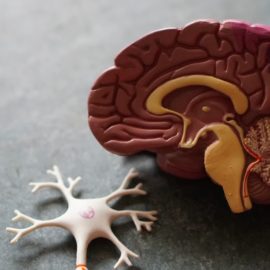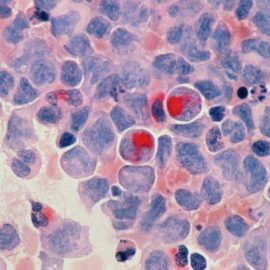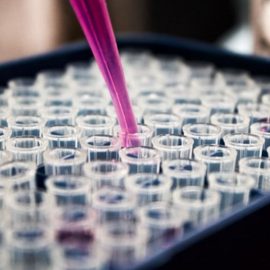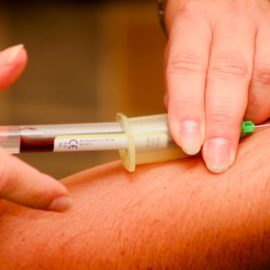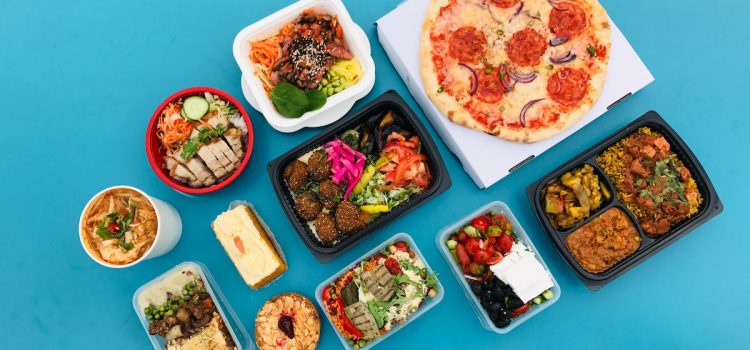

This article is an excerpt from the Shortform book guide to "Bigger Leaner Stronger" by Michael Matthews. Shortform has the world's best summaries and analyses of books you should be reading.
Like this article? Sign up for a free trial here.
Are you looking to burn fat and build muscle? What nutrients will help you do that? Are supplements recommended?
In Bigger Leaner Stronger, personal trainer Michael Matthews promotes flexible dieting—a method of eating that helps you trim fat and build muscle without sacrificing the foods you love. He shares five steps to creating a Bigger Leaner Stronger meal plan that works for you.
Read more to get the details on determining your goal, calculating your calorie target, calculating your calories-per-macro target, planning your meal schedule, and creating your meals.
Step 1: Decide How You Want to Change Your Physique
Before you can create your own Bigger Leaner Stronger meal plan, you must decide how you want to start changing your physique. You can prioritize losing fat, maintaining your current physique, or building muscle. Matthews explains that, unless you’re new to strength training, you can’t effectively lose fat and build muscle at the same time: trimming fat requires reducing calories, and having fewer calories available hinders your body’s ability to build muscle. Getting stronger and leaner typically requires alternating between phases of losing fat and building muscle. Matthews suggests you decide what to focus on first based on your body fat percentage.
Let’s now look at the three ways to start changing your physique: cutting to lose fat, maintaining to stay at your current weight, or lean bulking to build muscle.
Option #1: Cutting—The purpose of cutting is to trim fat. This approach requires you to eat fewer calories than you burn. Matthews suggests you start with a cutting phase if your body fat percentage is over 15%. Higher body fat takes longer to cut, requiring you to resist cravings longer, so working to reduce your body fat first makes it easier to succeed in subsequent cuts. End your cutting phases at around 10% to 12% body fat, as it’s harder to get leaner without intense diet control and exercise.
Option #2: Maintaining—The purpose of maintaining is to stay at your current weight and slowly build muscle. To do this, you must eat the same amount of calories you burn. According to Matthews, you should maintain if you’re happy with your physique.
Option #3: Lean Bulking—The purpose of lean bulking is to build muscle and strength. This phase requires you to eat more calories than you burn. While this optimizes muscle-building, you’ll also gain some fat in the process. Matthews suggests you end your lean bulk when you have around 15% to 17% body fat so you don’t gain too much fat you’ll need to cut later.
Step 2: Calculate Your Daily Calorie Target
Once you know if you want to cut, maintain, or lean bulk and whether to add or subtract calories from your diet, you must figure out the right amount of calories to eat daily. Consider three factors when calculating your target calories: your body recomposition goal, how active you are, and your weight.
Matthews suggests different ranges of calories to target when cutting, maintaining, and gaining. You should aim for the higher or lower end of this range depending on how active you are. If you’re less active, aim for the lower end. If you’re very active, aim for the higher end.
- If you’re cutting: Consume eight to 12 calories per pound of body weight daily. For most, this creates the 20 to 25% calorie deficit necessary to lose weight.
- If you’re maintaining: Consume 12 to 16 calories per pound of body weight daily.
- If you’re lean bulking: Consume 16 to 18 calories per pound of body weight daily. This typically creates the 10% calorie surplus needed for building muscle without gaining too much fat.
Step 3: Calculate Your Target Calories for Each Macronutrient
Once you know how many calories you should eat in a day, calculate how many calories you need to allot to each macronutrient (protein, carbs, and fat). The percentages that Matthews recommends are:
- Protein should make up around 30% to 40% of your daily calories. One gram of protein has about four calories.
- Carbs should make up around 30% to 50% of your daily calories. One gram of carbs has about four calories.
- Fats should make up around 20% to 30% of your daily calories. One gram of fat has about nine calories.
These percentages don’t need to add up to 100%—leave up to 20% free for treats (we’ll discuss how to add these to your diet later). To calculate your target calories for each macro, multiply your total daily target by the appropriate percentage in decimal form. For example, 2400 (total daily calorie target) x 0.3 (protein calorie target) is 720 calories of protein daily (or 180 grams).
Step 4: Plan Your Meal Schedule and What Foods to Eat
Once you’ve calculated your target calories, you can start planning your meals accordingly. While flexible dieting gives you the freedom to choose foods that you like, Matthews suggests you eat several portions of vegetables and fruits and get most of your calories from vegetables, fruits, whole grains, healthy fats, legumes, and tubers. When selecting proteins, Matthews recommends proteins from animal rather than plant sources because animal proteins tend to be better for building muscle.
| Create Your Food List With the Traffic Light System Another way to choose foods that are both enjoyable and nutritious is to consult physician Michael Greger’s traffic light system. In this system, green light foods are unprocessed plant foods, which you can eat in unlimited amounts (such as vegetables, fruits, and beans). Yellow light foods include processed plant foods and unprocessed animal foods (such as bread or chicken). If possible, Greger suggests you replace these with green light foods. Lastly, red light foods include heavily processed plant foods and processed animal foods (such as cupcakes or sausages), which Greger suggests you avoid. You’d likely want the majority of your proteins, carbs, and fats to be green and yellow foods and to reserve red foods as treats. |
First, decide how many meals to eat each day and when so you can plan out portions that meet your daily targets. For the most part, this should depend on your appetite, schedule, and overall preference. Matthews writes that most people eat four to six meals a day (including snacks) and suggests you eat at least two to improve your body’s ability to build muscle.
(Shortform note: There’s ongoing debate among researchers about whether meal frequency matters when it comes to health and weight loss. Some argue that eating frequent small meals is more beneficial than eating fewer large meals. They cite studies showing that eating frequent meals lowers the risk of diabetes and cardiovascular disease and enhances athletes’ physical performance and overall body composition. However, eating frequent small meals may increase hunger and make it more difficult to stick to diet plans. if you struggle with controlling meal portions or are too busy to prepare many nutritious meals, you may benefit more from sticking with three large meals a day.)
Next, create a list of your favorite proteins, carbohydrates, and fats (that are, ideally, nutritious and minimally processed) and write down some of your favorite treats. Include any drinks that contain calories. Matthews recommends you get no more than 10% of your daily calories from these drinks because they’re typically less nutritious and filling than foods.
(Shortform note: What does it mean for a food to be nutritious? Nutritious foods are nutrient-dense, which means they give you more vitamins and minerals per calorie than foods with empty calories—foods that give you few to no nutrients for the calories they contain. Nutrient-dense foods can help reduce the risk of obesity, heart disease, and certain cancers.)
Step 5: Create Your Meals
Now, you can use your daily calorie target, your macro calorie targets, and the list of foods you like to create your meal plan. To calculate how many calories a certain food or meal has, Matthews suggests you use online resources and find simple recipes that provide sufficient nutritional information for you to make your calculations.
(Shortform note: The USDA National Nutrient Database can be a helpful resource for determining the calories in foods and planning meals that meet your macronutrient targets. To use the database, enter the food item you’re interested in. Then, if applicable, select the brand to receive detailed nutritional information about the food. If you want to calculate the calories in a recipe, you can look up the calorie and macro information for each ingredient and enter it into a spreadsheet.)
Focus on one macronutrient at a time to make calculations easier. Each time you add a food to your daily meal plan, subtract its calories from your daily macro target. Add foods until you meet about 80% of each macronutrient target. Many foods overlap in carbs, fats, and proteins, which will make up for the rest of the calories needed for each target.
(Shortform note: If you don’t want to do macro calculations manually, you can use a macro tracking app that allows you to log your foods, set target calories, and plan meals that fit your macronutrient needs.)
Matthews recommends you build your meal plan in this order:
1. Add your proteins. Try to eat protein three times a day because it helps build muscle and manage hunger. Matthews suggests you eat at most 30 to 40 grams of protein per meal because there’s a limit on how much muscle your body can build from protein consumed in a single serving.
(Shortform note: There’s some research that supports Matthews’s suggestion to eat protein multiple times a day. Most people eat the majority of their daily protein for dinner. However, according to one study, people who ate protein-rich breakfasts had increased 24-hour muscle protein synthesis (which leads to greater muscle gains during strength training) compared with people who ate most of their protein in the evening.)
2. Add your carbohydrates. To ensure you get your nutrients in, Matthews suggests you add at least three portions of vegetables and then move on to other nutritious carbs like fruits and whole grains.
(Shortform note: Whole grains, vegetables, fruits, and legumes are considered the healthiest sources of carbohydrates, allowing you to get the proper minerals, vitamins, fiber, and phytonutrients. If you find it hard to eat more vegetables and fruits, try buying a wide variety from the store, finding recipes that include them, and making them more readily accessible when you’re hungry—by keeping pre-cut fruit in your fridge, for example.)
3. Add your fats. Matthews suggests you focus on foods containing mostly unsaturated fats, such as nuts, dairy, meats, and eggs.
(Shortform note: There’s considerable debate around the healthiness of different types of dietary fats. However, unsaturated fats are generally considered healthy, as they typically elevate “good” HDL cholesterol while lowering “bad” LDL cholesterol. High saturated fat and “bad” cholesterol levels, on the other hand, may be linked to heart disease and Alzheimer’s.)
4. Add your treats. These can be anything from your favorite sweets to drinks, including alcohol. Treats should make up the remaining calories after you subtract proteins, carbs, and fats from your total target calories. Matthews writes that you can allot up to 20% of your daily calories to treats.
According to Matthews, it’s occasionally acceptable to stray from your meal plan and have “cheat meals” or “cheat days” where you don’t worry about calories or macros. However, be sure to limit these to no more than two a week. Also, he advises you to avoid eating out at restaurants more than once a week when cutting and more than twice a week when maintaining or lean bulking. It’s often harder to estimate the calories and macros in meals you don’t prepare.
| Cheat Meals and Treats: Do They Help or Hurt? While some fitness experts and nutritionists recommend avoiding cheat meals altogether, others argue that cheat meals are not only acceptable but necessary for healthy eating. Let’s compare their opinions with Matthews’s advice and explore some factors to consider when figuring out how to fit cheats and treats into your diet. Instead of cheat meals, some nutritionists say that a better approach is to simply eat dessert every day. By leaving some room in your daily diet for treats, as Matthews suggests, you’ll avoid the temptation to binge eat and blow your diet. To stay healthy while eating treats every day, avoid eating foods with added sugars that you don’t count as treats. If you do decide to incorporate cheat meals or days into your diet, experts recommend you plan them in advance. All in all, most experts agree that having some flexibility to your diet—whether you allow yourself the daily treat, occasional “cheat meal,” or both—helps you stick with your diet longer and sustain a healthy eating lifestyle. |
Additional Nutrition Tips
Now that you know how to create a meal plan for flexible dieting, let’s consider some additional nutrition tips from Matthews for maximizing muscle gain and fat loss.
Eat Protein Before or After Your Workout
Matthews recommends you eat 30 to 40 grams of protein either within three to four hours before your workout or within an hour after. Eating protein before a workout provides your body with the necessary nutrients for muscle growth and helps start its muscle-building process. As your workout progresses, your body begins to break down muscle proteins at a higher rate. Eating protein after your workout ensures your body builds more muscle than it breaks down.
(Shortform note: Experts debate whether the timing of your protein intake matters. Some believe that you have only a short amount of time to eat protein after your workout to maximize muscle growth—a 30-minute period called the “anabolic window.” However, others say there’s evidence that simply eating enough protein daily is more important than timing.)
Supplements Help but Aren’t Necessary
According to Matthews, you don’t need to take supplements to achieve your ideal physique. However, there are four supplements that can make it easier to get the nutrients you need.
Protein Powder: Powdered forms of protein (such as whey or casein) can help you to meet your daily protein goal. However, limit protein powder to less than half of your daily protein, as too much can cause gastrointestinal problems and protein-rich foods tend to be more nutritious and filling.
(Shortform note: While protein powders can be a convenient way to meet your protein target, some experts suggest you choose your powder carefully. Protein powders aren’t regulated by the Food and Drug Administration, meaning it doesn’t verify that they’re safe for consumption. Indeed, one study found that many protein powders contained high levels of lead and BPA, as well as contaminants like mercury and arsenic. To choose quality protein powders, look for third-party-tested products and research brands carefully.)
Fish Oil: Omega-3 is an essential fatty acid found in fatty fish, flaxseed, and walnuts, with many health benefits such as reducing inflammation. Consuming sufficient amounts can be hard to do with food alone.
(Shortform note: In In Defense of Food, Michael Pollan argues that omega-3 is possibly the most essential of all nutrients. In addition to reducing inflammation, omega-3 has numerous other benefits: It helps your brain development, vision, and metabolism, and it can even alleviate psychological disorders such as depression. Some experts caution against getting your omega-3s through fish oil, however. In How Not to Die, Michael Greger suggests you get your omega-3s through algae oil or yeast products, arguing that fish oils contain PCBs, mercury, and pollutants, which can harm your cognitive performance.)
Creatine: A substance made of amino acids that your body naturally produces small amounts of. Creatine can improve muscle growth and recovery.
(Shortform note: Creatine benefits your brain health, too. There’s evidence, for example, that regularly taking creatine monohydrate can help prevent neurodegenerative conditions like Huntington’s and Parkinson’s diseases.)

———End of Preview———
Like what you just read? Read the rest of the world's best book summary and analysis of Michael Matthews's "Bigger Leaner Stronger" at Shortform.
Here's what you'll find in our full Bigger Leaner Stronger summary:
- How to get the physique you want without trendy diets or brutal workouts
- A simple and scientific approach to nutrition and exercise
- How to plan a workout program based on progressive overload


